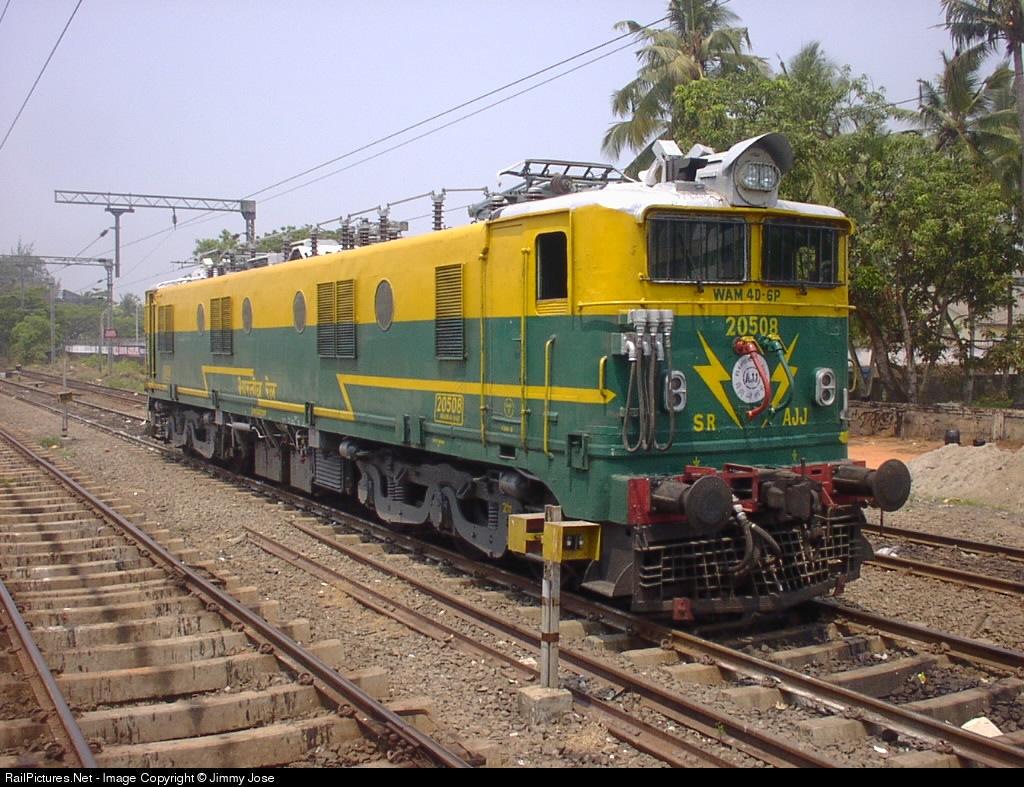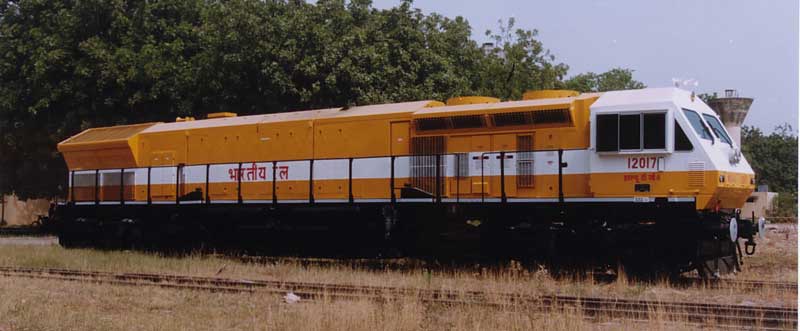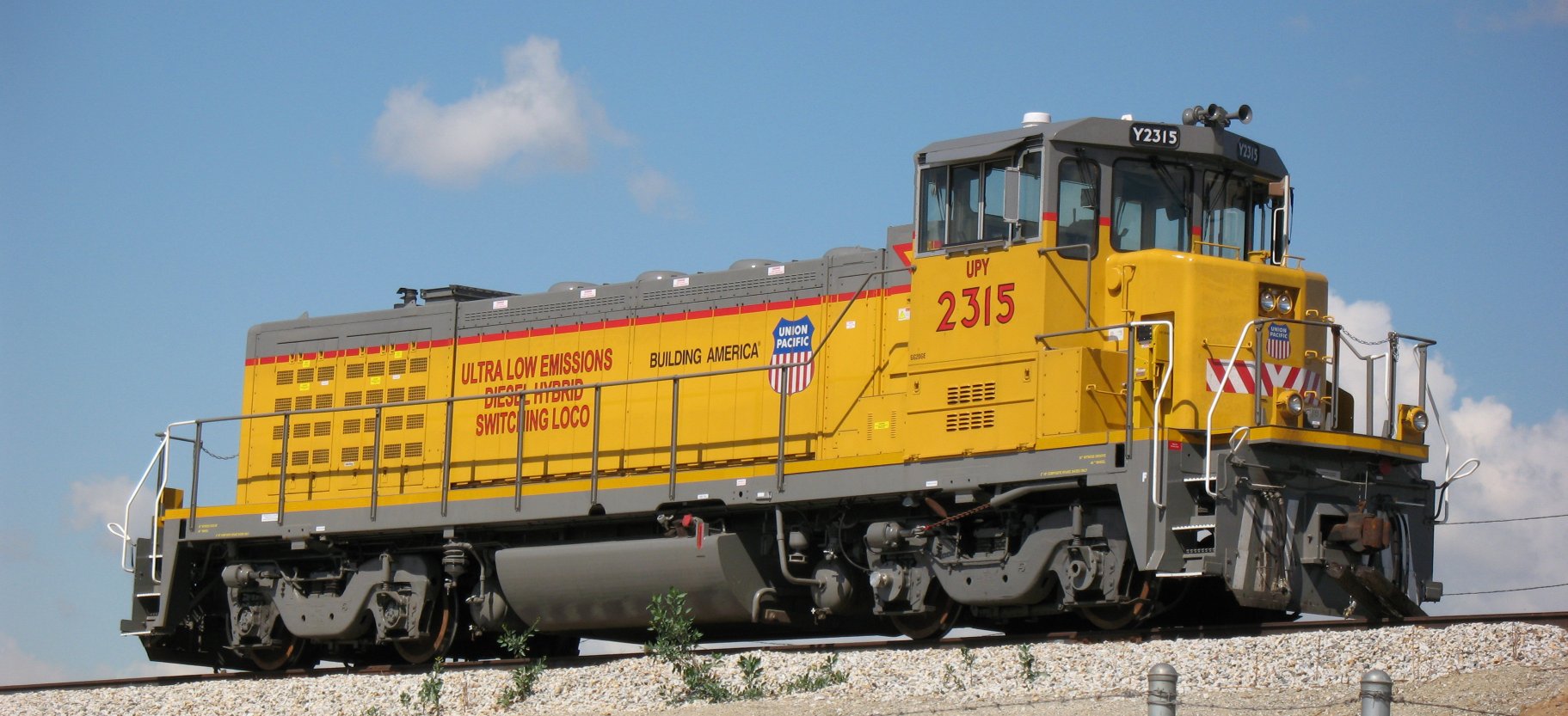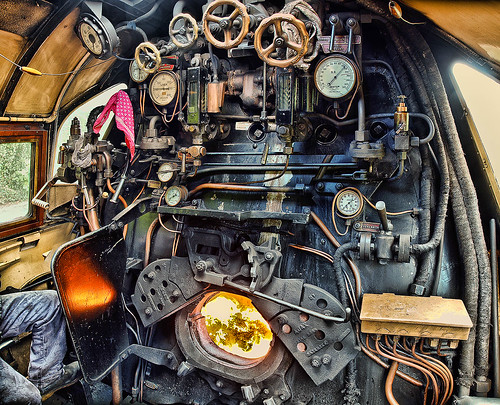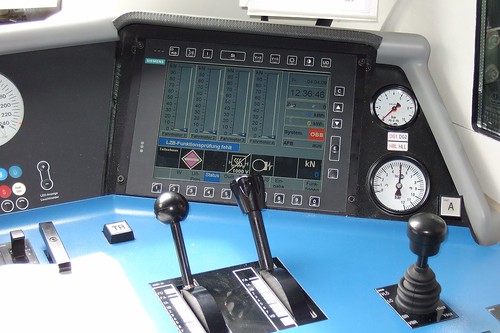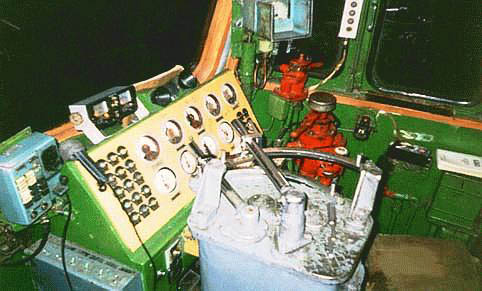WAG5WAG-5Introduced in 1984. Power 3850hp (some documents say 3900hp, which may be a later modification), 6-axled (Co-Co). Starting TE 382kN (33500kgf); continuous TE 202kN (20600kgf). Adhesion 29%. A very successful class, and probably the one with the most numbers produced. There are many variants of these, starting with the plain WAG-5. WAG-5A locos have Alsthom motors. Later versions were WAG-5H and variants with Hitachi motors: WAG-5HA by CLW, with high-adhesion bogies, and WAG-5HB WAG-5HBbuilt by BHEL to RDSO's specifications. (Note: Lallaguda shed uses the simple code 'WAG-5' for locos that would normally be denoted 'WAG-5HA'.) [4/02] Newer versions have been spotted: WAG-5HG, WAG-5HR, WAG-5RH (here the 'R' is believed to denote rheostatic braking, but not all WAG-5 class locos that have rheostatic braking use this suffix), WAG-5D, WAG-5P for fast passenger traffic (mail and express trains) with gear ratio 21:85. etc,. WAG-5HE variants are believed to have Hitachi traction motors and only air brakes.
The detailed differences among these variants are not precisely known. Specifications for the base WAG-5 model are given below. Some of the variants are known to have different gearing and equipment, and different rated speeds. The original WAG-5 units had a top speed of 80km/h. Many variants have a gear ratio of 21:58, the same as that of the WAM-4 6P, which allows these WAG-5 locos to be used for mixed applications including hauling passenger trains at 100km/h.
Auxiliaries are from many sources: typically Elgi compressors, Northey exhausters, and other equipment from S F India, but many variations exist. Speed control by parallel combinations of motors and weak field operation. Air brakes for loco, dual train brakes are original equipment.
Although a great improvement over earlier locomotive classes, the WAG-5 models do have limitations, one of which is the inability to start and haul large loads (4700t -- 58 BOXN wagons) on gradients steeper than 1:200 or so.WAG-5 locos can be used as multiple units in configurations of 2, 3, 4, or more locos.
With the large influx of WAG-7 and WAG-9 locos in recent years, many WAG-5 locos are now also being put to use hauling local passenger trains. Some such as the WAG-5E loco #23989 'Krishnaveni' (of Vijayawada [1/04]) have also been modified for this purpose in their interior equipment as well as some of the exterior aspects. For some reason, the BHEL-built WAG-5HA / 5HB locos are never seen used with passenger trains. All of the WAG-5HB units are at Jhansi near BHEL's own installations so that BHEL can handle their maintenance.
The WAG-5B locos are converted WAM-4 units. These have road numbers in the range - 21101 to 21138. This is believed to have stemmed from a decision to have a separate line of freight loco models based on the highly versatile and successful WAM-4 family of locos.
In the external appearance of WAG-5 locos, it can be seen that locomotives with road numbers up until 23293 have side louvres and round glass windows like the WAM-4 locos showing the legacy of the WAM-4 design. From number 23294 onwards the locos have the newer WAP-4/WAG-7 style of louvres, thought to be for better ventilation.
More recently WAG-5 locos of all types have been retrofitted with data loggers, flasher lights, train parting alarms, etc.
WAG-5 #23026, homed at Bhusawal, was selected for a trial project by the RDSO to develop designs for adoption of thyristor controlled electricals for the tap changer based locomotives in 1995. The project was began in 1992 because there was an increasing dearth of suppliers for the tap changer control, it was inefficient and so the new system, promising better performance, was to be retrofitted after trials into all the older locos. A prototype system, developed in collaboration with Bhabha Atomic Research Centre, was fitted in this locomotive and trials were carried out between 1997 and 1998. However, due to several problems, the biggest of which was intereference caused with signalling equipment, the project was dropped in 1999. The loco was then refitted with the standard equipment and brought into service as a WAG-5P which it is till this date [1/05].
Traction Motors: Alstom TAO 659 (575kW, 750V, 1070 rpm) or TAO 656; or Hitachi HS 15250A (See description under WAP-4.) Axle-hung, nose-suspended. Six motors.
Gear Ratio: 62:16 or 62:15 with Alstom motors, some 64:18 (Hitachi motors), many now 58:21 for mixed use.
Transformer: BHEL, type HETT-3900. 3900kVA, 22.5kV, 182A. 32 taps.
Rectifiers: Silicon rectifiers (two) using 64 S-18FN-350 diodes each from Hind Rectifier. 2700A / 1050V per cubicle.
Bogies: Co-Co cast bogies (Alco asymmetric trimount -- shared with WDM-2, WAM-4).
Axle load: 20t
Max. Haulage: 2375t
Pantographs: Two Faiveley AM-12
Current Ratings: 1100A/10min, 750A continuous
Comparative Specifications
---------- Post added at 08:41 PM ---------- Previous post was at 08:41 PM ----------
WAG–6WAG-6A.Photo by Dr.MSM Saifullah WAG-6A models are from ASEA (bodies by SGP in Austria and transported to ASEA, Västerås, Sweden on freight wagon type bogies. Trivia: The second body (26001) passed Malmö in southern Sweden on 1987-09-01). ASEA had a specially constructed piece of 1.676m Indian broad-gauge line to allow testing of the locomotives before delivery. Delivery was to Göteborg harbour on standard-gauge bogies, where they were fitted with broad-gauge bogies before they were placed on board. The first shipping was planned to begin December 1987 with another batch in January 1988, although the actual shipping dates were probably later. The WAG-6B and WAG-6C models are from Hitachi. They are all 6000hp locos with thyristor-controlled DC traction motors. Until about 1993 they were the most powerful freight locos in IR's fleet. The development of this technology (chopper control) stopped when the (better) AC motor technology was introduced in IR in the form of the WAP-5 and WAG-9 locomotives.
Six bogie-mounted separately excited DC traction motors are used, and speed control is via the manipulation of the phase angle by a thyristor converter and a separately powered field coil. Microprocessor control with ground speed detection (slip control) and creep control system to maximize adhesion. Air brakes for loco and train; dynamic brakes provided. WAG-6A and WAG-6B locos have Bo-Bo-Bo wheel arrangements, whereas the WAG-6C locos have a Co-Co arrangement. The WAG-6 series locos are the only ones with 'vestibules' to connect between MU'd locos. WAG-6A locos have half-height vestibules and WAG-6B and WAG-6C locos have full-height vestibules.
The WAG-6A body shells were built by SGP in Austria; the rest of the locos were built and the entire units assembled in Västerås, Sweden by ASEA. ASEA constructed a special length of 1.67m (BG) track for testing these before delivery. The locos were fitted with BG bogies at Göteborg harbour after being transported there on standard gauge bogies. The first WAG-6A was delivered around December 1987 and the remaining five in January 1988.
WAG-6B.Photo by Dr.MSM SaifullahAll WAG-6 locos were (are [1/04]) at Waltair (Vishakhapatnam) and have generally been used for ore freights and material trains on the Kirandul-Kottavalasa line. Until about 1999 or 2000, they were in regular service, although maintenance problems began affecting their service from about 1997. Later, repeated problems have been experienced with the unavailability of spare parts which kept them from getting needed periodic overhauls. In Oct. 2002 the WAG-6A were technically suspended from operations for POH for a while. Most of the WAG-6B and WAG-6C were also similarly suspended at different times.
However, many of them still labour on – see below. Spare parts have since been ordered for them [12/03] as special case procurement in some cases, and indigenous manufacturers have been invited to duplicate parts that are no longer available from the original manufacturers. In some cases parts are cannibalized from one loco for another. A particular electronic card for the on-board computer is said to be [1/04] in severe short supply and unavailable from ABB and Hitachi; ECIL and DRDO are attempting to duplicate them. It is alleged that these locos were procured by the Railway Ministry without consultation with RDSO, hence the problems with maintenance and spares. For political reasons, it is also considered not feasible to simply scrap these locos right away.
Status [1/04] WAG-6A locos #26000, #26001, #26002 and #26005 were in working order and used on the KK line. #26003 and #26004 were awaiting POH. WAG-6B locos #26010, #26011, #26012 and #26013 were under POH. #26010 went on a trial run to S. Kota and returned with some minor problems but will be ready to re-enter service MU'd with #26011 which is almost ready. WAG-6B locos #26014 and #26015 were waiting their turn for POH. Of the WAG-6C locos, all six (#26020 - #26025) were in regular use on the KK line; one or two of them have shown issues with wheel slip.
Status [8/05] Of 18 locomotives, 14 are said to be in service, 2 getting their POH, and 2 are out of service awaiting POH.
The WAG-6A models are said to be upgradable to 160km/h but IR never tried this out. All WAG-6 variants can be used in MU pairs but not with more than 2 locos.
Traction Motors: ASEA make (WAG-6A), L3 M 450-2. Six motors, fully suspended, force-ventilated, separately excited, 3100kg ; (WAG-6B) Hitachi HS 15556-OIR, bogie mounted, force-ventilated, compound-wound, 3200kg ; (WAG-6C) Hitachi HS 15256-UIR, axle-hung nose-suspended, force-ventilated, compound-wound, 3650kg.
Transformer: (WAG-6A) ASEA: TMZ 21, 7533kVA; (WAG-6B/C) Hitachi AFIC-MS, 6325kVA.
Thyristor controller: (WAG-6A) 24 YST 45-26P24C thyristors each with 24 YSD35-OIP26 diodes, 2x511V, 2x4500A; (WAG-6B/C) 32 CGOIDA thyristors each with 24 DSP2500A diodes. 2x720A, 850V.
Pantographs: (WAG-6A) Two Stemman BS 95; (WAG-6B/C) Two Faiveley LV2600
---------- Post added at 08:42 PM ---------- Previous post was at 08:41 PM ----------
YAM–1 YAM-1.Photo by Bharath MoroThese cute little B-B MG electrics, 20 in number (18 ordered first, two later) were supplied by Mitsubishi in 1964 and worked on SR, especially in the Madras area, until the recent conversion to BG of the mainline tracks. These were later [12/03] run on the Tambaram - Villupuram section of the mainline. On June 30, 2004, the last YAM-1 run took place, minutes after the last MG EMU service on the Chennai network reached the Tambaram station. The remaining YAM-1 locos are now at Tambaram, only occasionally energized for departmental work. One unit is [2/05] at CLW, apparently undergoing preservation work prior to being plinthed.
They have monomotor bogies, with two bogie-mounted DC motors permanently coupled in parallel. They are not very powerful, although they have been used to haul some longish (50-wagon) goods trains on occasion. Air brakes for loco, vacuum train brakes. Oerlikon compressor and exhauster, Arno rotary convertors.
Now [11/01] one is said to be at the Chittaranjan Loco Works. There are rumours that some or all of them may be refurbished and exported to some other country.
Manufacturers: Hitachi
Traction Motors: ACEC/Alstom/Siemens MG1420 (two). Fully suspended, force-ventilated. 5600kg. 1080kW, 1250V, 920A, 630 rpm
Gear Ratio: 3.95 : 1
Transformer: Mitsubishi 'Shell Sub', 1690kVA, 25 taps.
Rectifiers: Secheron excitron rectifiers, type A268 (four). 510A/1250V
Pantographs: Two Faiveley AM-12.
---------- Post added at 08:42 PM ---------- Previous post was at 08:42 PM ----------
NBM–1Battery-electric locomotives used by CR on the Gwalior lines. These were built by BHEL in 1987; only three units were built.
Comparative Specifications
BBCIThe BB&CI Railway had two battery-powered shunters for use in yards at Bombay. There were only two of this class, and they were imported from the UK in 1927.
---------- Post added at 08:43 PM ---------- Previous post was at 08:42 PM ----------
WAM–1 Early 2800 hp SNCF design for 25kV AC, with ignitron rectifiers. Introduced in 1959, they were mostly deployed by ER in the Howrah-Asansol-Dhanbad-Mughalsarai section. They were less frequently found 'upstream' in the Delhi-Kanpur-Mughalsarai section, and in the Igatpuri-Bhusaval section of the Central Railway. Mostly used for non-express passenger trains, but some were used double-headed for freight service. Some were still [12/98] in operation on ER (Sealdah-Lalgola passenger, etc.).
WAM-1's are significant in the history of electric traction in India as they were among the first AC electrics to run in India. Like the WAG-1's, some of their advanced features turned out to be unsuitable for Indian conditions.
Manufactured by Kraus-Maffei, Krupp, SFAC, La Brugeoise & Nivelle (50 cycles European group). Ignitron rectifiers feeding four DC traction motors accepting pulsating current input. Motors are connected to the axles by a Jacquemin drive. Speed control by tap-changer on input transformer (motors permanently wired in parallel). Superstructure mounted on bogies with pendular suspension with equalizer beams. Electricals from ACEC, AEG, Alstom, Brown Boveri, Siemens and others. B-B (monomotor bogies). Jeumont transformer (20 taps), Oerlikon exhauster, Arno rotary converter. Air loco brakes, vacuum train brakes.
Manufacturers: Kraus-Maffei, Krupp, SFAC, La Brugeoise & Nivelle (50 cycles European group)
Traction Motors: Siemens/ACEC/Alstom MG 710A (740hp, 1250V, 480A, 1000 rpm, weight 2750kg). Fully suspended, force-ventilated.
Rectifiers: Four water-cooled ignitrons from SGT, each rated for 575kW / 1250V.
Pantographs: Two Faiveley AM-12.



